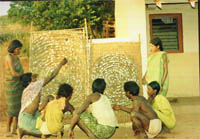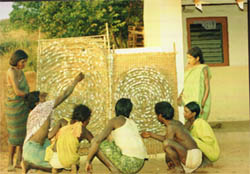SERICULTURE
Transfer of Technology to Other Areas
In the past one year staff visited Dasamanthpur, Pottangi (Koraput District ) and Bonda Hills (Malkengiri District). From these Blocks, three villages were chosen for the proposed sericulture model village. The main purpose of the visit was study the possibilities of transfer of sericulture related scientific technology in these new areas. Villages selected for sericulture programmes were Gojiaguda (Dasamanthpur Block), Gangamguda (Pottangi Block), and Dantipoda (Bonda Hills). A group of 15 farmers, 5 persons from each of the three villages received sericulture training at IRDWSI project office for five days. A demonstration of silk worm rearing was conducted for fifteen days, encompassing mulberry plantation, silk worm rearing and inter cropping within the mulberry farms. During this period, the core team identified wasteland (rain fed condition) for mulberry plantations. In Dasamanthpur area, the saplings were as tall as 1 metre. In Bonda Hill mulberry seedlings was cultivated on the slopes. Depending on the types of land, land preparation work was carried out. In Dantipoda village tree system (4 x 4) was introduced to suit the rain fed condition of the soil.
- Sericulture Programme
- Natural Dyes Programme Sustainable Agriculture Programme
- Aqua-culture Programme
- Skills training & Production units
- Decentralized Energy Options - Mini Hydro Power Project and Solar demonstration and feasibility study
- Information Technology-Computer Training Centre
Extension Area Visits and Study - Village - Gojiaguda
In Gojiaguda, fourteen households of 52 people from the Khond community reside in the village. Due to lack of suitable lands for mulberry plantation, the small patch of land used for agricultural and vegetable cultivation was upgraded and gradually converted into sericulture farm. The villagers used to raise only one crop through the year. After the team's intervention through sericulture, the people are now acquainted with the method of inter cropping and continue to raise their food crops. Now, they cultivate twice or thrice in a year on the same lands along with mulberry. To preserve the soil fertility they planted crops like Sun Hemp, Beans, Dalchi (Nitrogen fixation plants) and applied organic manure at regular intervals.
Initially, mulberry plantation was carried out with the assistance of 5 farmers from the village. All together 36,000 mulberry saplings have been planted in 3 acres. Taking into account the season for cultivation, plantation was taken up in July and August. The project provided the necessary seedlings of the variety M5 variety suitable for rain fed condition. The method adopted was of pit system ( 2 x 2).
Village - Dantipoda
In this village five families have been engaged in mulberry plantations. A total of 16,000 mulberry seedlings were planted in the surrounding areas. Besides the main crops, people could not grow any other crops because of infertile soil conditions and slope lands. Plantation work commenced after the consent and with the willingness of the people. In lieu with the topography of the region M5 variety was supplied. Tree type system ( 4x 4 ) of plantation was introduced.
Village - Gangamguda
Gangamguda village comprise of 42 families belonging to two different Adivasi communities (Konds and Konda Dora). The economic status of the people is very poor to that of the neighbouring villages. In the village, two persons from Konda Dora and 3 from Khond community are actively engaged in the sericulture programme. Mulberry plantation was carried out and M5 seedlings were planted on the 5 acres of waste land adopting pit system (2 x 2 and 4 x 4).
Old Villages Follow Up and Study -Village - Khondpungar
Mulberry plantation was started four years ago in this village. However, as the force of nature take its toll, about 1.5 acres of mulberry seedlings were completely hit by lightning within a forth night of plantation and another 15,000 seedlings were destroyed by white ants. Attempts were made to raise additional mulberry seedlings to make up the lost. For this, seedlings were supplied by the project. In the absence of fencing facilities, M5 variety trees saplings were planted.
Silk Worm Rearing
The fourth silk worm rearing commenced in September at the project office in Semiliguda. In the process, fifteen farmers were trained for fifteen days. These groups of farmers were the same people who had been trained earlier.

Utility of by Products
In the laboratory at the office various research and experiment work were carried out. One of the experiment and the process was to extract fine fibre from the waste extracted from mulberry cuttings. Pruning was normally done in June and July as the climatic conditions was found to be most favorable. After pruning the mulberry cuttings, the peel was removed. After more than six months from the date of mulberry plantation the mulberry cuttings yielded good fibre in quality. In order to extract good fibre quality the height of the plants must be not less than 6 feet from the ground level.
Use of Mulberry Shoots
Mulberry shoots are widely used in agricultural farms as fuels. The mulberry shoots are either used as they are or after converting them into coal. It is important to note that the outer coverings of the shoots should be removed for other purposes. Only the central portion of the plant is to be used as fuel woods.
From the mulberry shoots fibres can be extracted and used as supplementary cotton. Fibre for use in spinning and jute like fibres are being produced. Artificial leather can be made by processing the mulberry barks. Furthermore, it can be used for making ropes, nets and baskets etc.
Process of Extracting Mulberry Fibres
A simple technique was adopted to extract fibres from the plants. After selecting and pruning the mulberry cuttings, the pills from mulberry and makita have been sliced off piece by piece. Later these pills are soaked in water for 15 to 20 days by following the flow of water current. If it is soaked in a storage water like (ponds) then 15 days is sufficient,. But if it is dipped in a running water (stream, river, etc.) it should not be less than 20 days.
After completing the procedure (20 days) take out the pill and wash it in the running water twice or more until it becomes white in colour. Bask the white colour fibre under the sun till it does completely. This fibre can be used to produce various handicraft items.
Mulberry Leaves Utility
Mulberry leaves can be used for preparing a decoction known as mulberry tea. As usual, the tea is prepared only with mulberry leaves. However, some people prefer to boil mulberry roots and stems to prepare broth which is believed to be effective in lowering the blood pressure.
Mulberry leaves are also used as cattle feeds. For instance, a rabbit nourished on mulberry leaves grew well. Their body weight increases and the growth of fur are found to be more fluffy and thicker than those fed on dried grass. They accumulate more fat and the content of water particles in their tissue is very less. In the same way, a cow fed on mulberry leaves tend to produce more milk. The milk is tastier and more condensed than those nourished on grass.
After the completion of silkworm rearing in late autumn, which is also the last rearing season, the left over mulberry leaves in the garden can be collected and judiciously utilised as cattle feeds.

Study on 5% Model In Sericulture Demonstration Field
In Semiliguda, the types of soil mainly composed of red soil amalgamated with rock particles. The type of soil in the demonstration field are red soil and rain-fed condition. In this area a study on 5% model ha:; been under taken in one acre of mulberry plantation.
Experiment was conducted on 50 cents of land for 5% model and 50 cents of land for non 5% model. In both the cases, M5 variety of mulberry plants were planted. Along with it 55 numbers of model pit system was instituted in the same plot. The size of the pits were 3 mts in length, 2 mts in width and 4 mts in depth. In Koraput District, the maximum rainfall range between 1200 to 1400 per annum. Depending on the amount of rainfall the level of water table extend from 25 ft to 40 ft. In the past one year the magnitude of ground water in the demonstration field stood between 15 ft to 20ft. Following are details of observations:
Study on 5% model in Sericulture Demonstration Field - Mulberry Plantation
| Sl.No | Item | Land under 5% model | Non 5% model land |
| 1 | Land | Dry land | Dry land |
| 2 | Irrigation | Rain field | Rain field |
| 3 | Plantation growth | 3.05 metres | 2.00 metres |
| 4 | Leaf yield for 1 plant | 7.00 Kg | 4.00 Kg |
| 5 | Plant growth period | 3.00 months | 4.00 months |
| 6 | Leaf harvesting period | 3.00 months | 4.00 months |
| 7 | Nitrogen % | 170.00 % | 50.00 % |
| 8 | Leaf starvation time | 5:00 hours | 3:00 hours |
| 9 | Larva weight | 12.00 Gms | 1 0.00 Gms |
| 10 | Randita | 7.00 Kg | 9.00 Kg |
| 11 | Silk Ratio | 110.00 % | 90.00 % |
| 12 | Cocoon weight for 1 kg | 600.00 Nos. | 800.00 Nos. |

